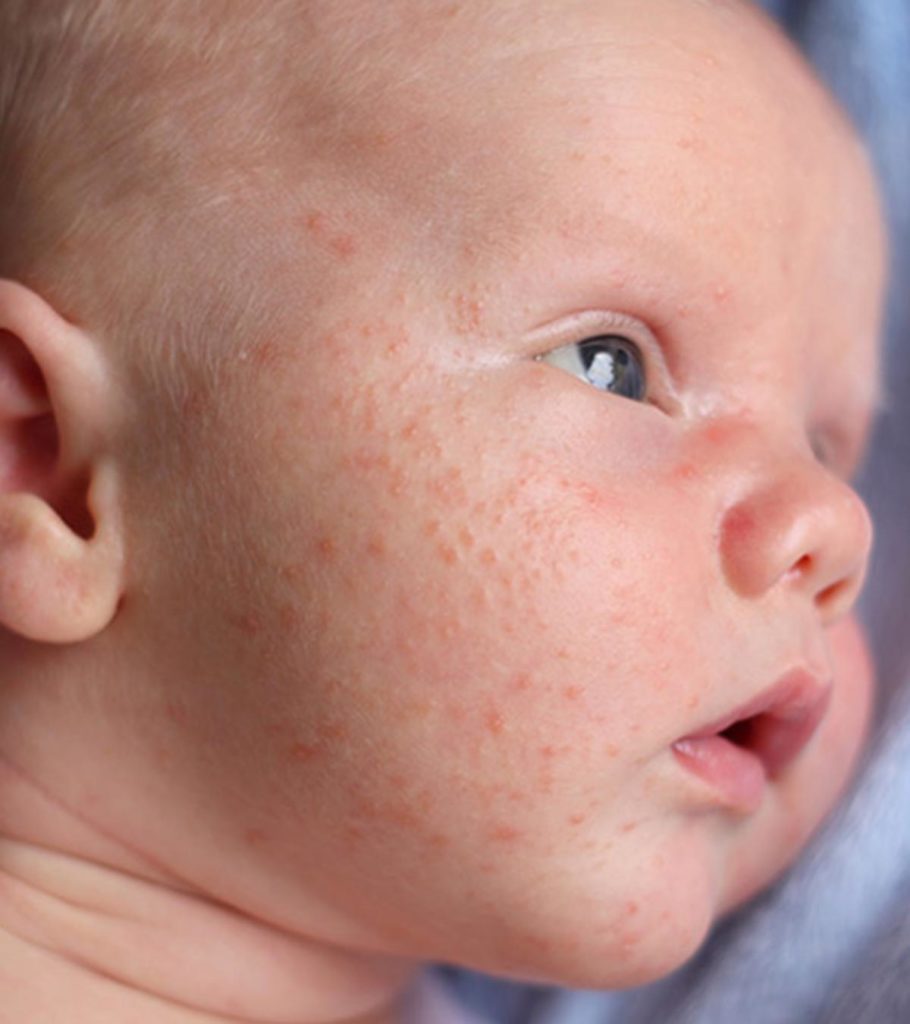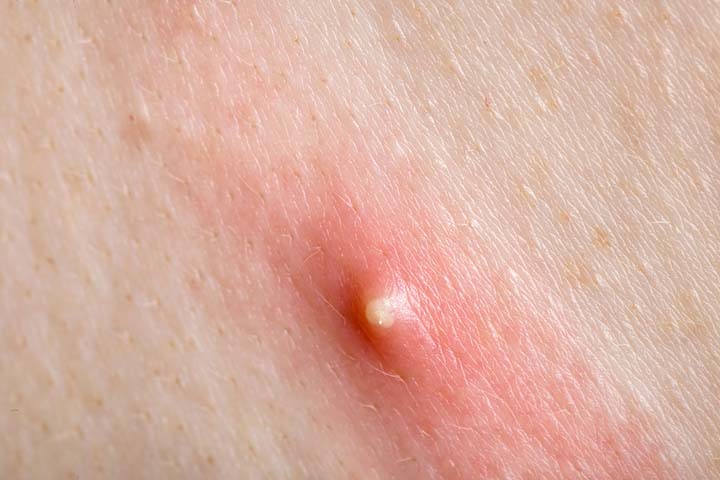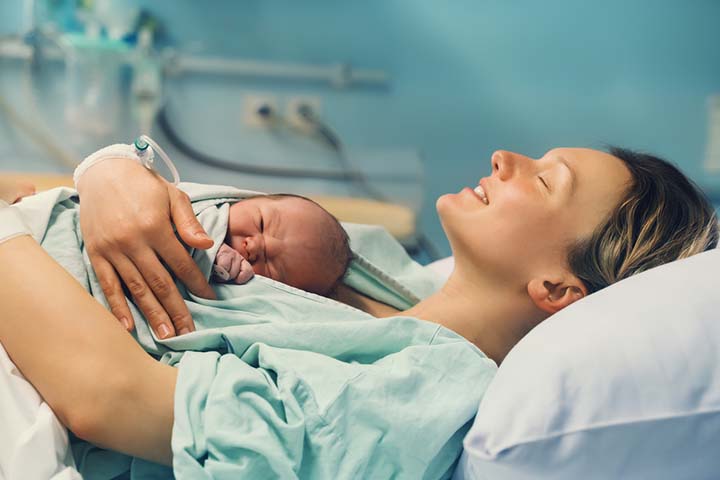You may observe tiny blisters appearing on your baby’s skin that resemble acne. But, can babies have acne? Neonatal acne or baby acne is a skin condition that may affect about 20% of newborns. It may occur in babies as young as three weeks of age. The pustules (bumps or pimples) usually appear on the face (mostly on the cheeks) and, at times, the scalp. The condition generally does not require treatment with medications (1). However, you should consult a doctor and not use any creams or lotions available over the counter if you are concerned. This post discusses the causes, symptoms, treatment and, prevention of neonatal acne.
What Is Baby Acne?
Erythema toxicum neonatorum, better known by its colloquial name baby acne, is the formation of yellow or white-headed blisters or papules surrounded by red skin on cheeks, forehead, neck and parts of the torso like the chest. They can even appear on legs, predominantly on thighs. Baby acne may look very similar to other baby skin conditions (more about them later). Therefore, do not confuse it with them.
The red blisters of baby acne usually appear and disappear over the course of days or even hours. Although they seem nasty, they are harmless. In fact, your baby will be least bothered about that acne and will continue to behave normally.
Types Of Baby Acne
There are two types of acne that affect babies at two different stages of their infant life:
- Neonatal acne occurs in newborn babies around three weeks of age. It is characterized by red to pink lesionsiXAn area of abnormal tissue seen as sores, acne, cuts, or birthmarks induced by injury, infection, or underlying condition that do not have a head and do not protrude as a bump. This acne is limited to the face predominantly to the cheeks and only sometimes on the scalp. It is a mild condition and does not cause any discomfort to the baby since it is not itchy.
- Infantile acne happens only after the baby reaches three to four months. Infantile acne is much more severe than neonatal acne since the lesions are quite inflamed and form papules. The inflammation may also lead to discomfort to the baby, which may cause the baby to itch or prick at the papules.
How Long Does Baby Acne Last?
Neonatal acne may last a month and clear away without any scarring. In some cases, it may last a couple of months and then clear away without medical intervention.
On the other hand, infantile acne could last for months but will show signs of fading once the baby turns twelve months old. However, this acne has a tendency to persist until three years of age, in which case they leave a permanent scar. Medical intervention may be required in case of infantile acne.
Symptoms Of Baby Acne
Baby acne usually affects parts of the face but can also be found on neck, chest and sometimes on the scalp. The symptoms include red patches or red blisters that cover a localized section or are distributed in various parts of the body.
Infantile acne looks quite similar to adolescent acne since they may also show pustules, which are pimples. This acne can be itchy, and the baby will try to scratch the affected area.
What Causes Baby Acne?
There is no known cause for baby acne, and even medical practitioners are perplexed by it (2). There are hypotheses though, and we have listed the popular ones. Note that these are not the confirmed reasons for baby acne but just the popular theories about probable causes:
1. Transfer of hormones from mother:
The transfer of maternal hormones from breast milk to the baby is often considered a reason for baby acne (3). In case a newborn displays acne within a few hours of birth then the transfer of hormones could have happened through the placenta in the womb. It is speculated that these hormones may affect the baby’s sebum production. An excessive sebum production can clog the pores and cause acne.
Breast milk is the safest food for a baby, even if it is laden with maternal hormones. It is never known to cause any skin problems. In fact, it improves the baby’s resistance thanks to its antibodies.
2. Immaturity and sensitivity of the skin:
Babies have a developing epidermis, the outer layer of the skin. Their skin can be so sensitive that it is easily affected by simple events such as a change in temperature, contact with an abrasive material or even too much pressure at a point.
All babies have sensitive skin. Thus, this theory does not explain why some babies suffer from acne while some never get it.
3. Allergic reactions:
The acne could be considered a complication of a certain allergy (4). It could be an allergy to a food or medication. Skin hives and eczemaiXAn inflammation of the skin accompanied by itchiness and dryness commonly triggered by an allergen are common manifestations of an allergic reaction. Although they may seem similar, skin hives and eczema are different from baby acne. Baby acne does not cause any discomfort to the baby nor is life-threatening. Moreover, babies that are exclusively breastfed and non-allergic may also show acne.
Do Certain Foods Cause Baby Acne?
It has not been scientifically proven that any food consumed by the mother, like fatty or oily food, causes baby acne. Since babies do not eat the food, which adolescents suffering from acne eat, the possibility of acne being caused by an ingested food can be ruled out in the case of babies.
Thus, baby acne does not have a specific cause and can be conveniently described as a spontaneous event. Changes in skin structure due to its constant growth and development could be a reason since baby acne is less prevalent in premature babies whose skin is yet to attain the level of a full-term baby (5). It is a theory that is not scientifically proven and is just a speculation. As a parent, you need not worry about harmless baby acne, but there can be situations when you must take your little one to the doctor.
When To Take The Baby To A Doctor?
Baby acne is not fatal and should not be a source of constant worrying. But there are certain situations in which you must promptly bring the condition under medical supervision:
- If the acne is too brightly red and oozes a clear discharge.
- If the acne has yellowish heads, indicating pus formation that occurs when there is a bacterial invasion of the blister.
- When the baby is in extreme discomfort due to the acne. He repeatedly cries while trying to scratch the acne.
- When the baby acne is accompanied by high fever, indicating an infection.
- If you suspect it is something beyond baby acne, a skin problem such as eczema.
An inspection of the acne by a doctor can help make an accurate diagnosis of the condition.
How Is Baby Acne Diagnosed?
Diagnosis is clinical and does not require any invasive testing. This means your pediatrician will diagnose the condition just by looking at the blisters. In case, he intends to do a detailed analysis, he may then take a few scrapings of the lesion and send it for laboratory testing. A blood test can also help determine if the condition is indeed baby acne but is usually not required.
How To Treat Baby Acne?
Still wondering As astonishing as it may sound, there is no treatment for baby acne. The primary reason is the fact that there is no known cause for baby acne thus making it impossible to prescribe a medicine without knowing the target. Baby acne itself is completely harmless and is never dangerous. It may last for a few days or a month but will disappear without your intervention.
Jessie C, a mum of two children, shares her experience on her blog when her babies, Brayden and Lincoln, suffered from baby acne. She says, “When Brayden was a baby, he had baby acne. His doctor said it would go away on its own. His did go away pretty quickly. Lincoln had baby acne, and it just stayed/got worse. I mixed water and baking soda together to make a paste. I put it on his face while he was in the bath. I let it sit while I washed his hair, etc, I rinsed it off. After the bath, to counteract the drying effect, I used a face moisturizer. After just a day, it was fading away, and soon enough, it was ALL gone (ⅰ).’’
Your pediatrician is quite likely to advise you to leave the condition untouched.
However, he might suggest some medicine to provide relief for the baby’s skin.
Medication For Relief
The pediatrician will most likely prescribe a topical ointment consisting of compounds such as ketoconazole, benzoyl peroxide, and hydrocortisone.
In addition to such ointments, you may be tempted to try some home remedies or natural baby acne treatment. So what are the best home remedies for baby acne treatment? Read on.
Are There Any Home Remedies For Baby Acne?
First a word of caution. Do not try any over-the-counter acne medication for your baby nor use a cream, lotion or soap without your doctor’s advice. Most non-prescription acne medications are for adolescents and adults. Do not even use essential oils, creams or scrub the baby’s skin during bathing.
There are certain home remedies such as oatmeal bath that aim at moisturizing the baby’s skin but have not been medically proven to treat baby acne. All these can actually worsen the condition. If there is anything you can do to help your baby’s skin to be healthy, then it is the following:
Breast Milk For Baby Acne:
Breast milk provides the best nutrition for your baby. It is rich in powerful antibodies that protect the baby from pneumonia and diarrhea-causing pathogens (6). It also protects the baby from developing allergies.
Breast milk also has antibacterial properties due to the presence of lysozyme, an enzyme that inhibits microbial growth. You can express some milk from your breast and dab it on your baby’s acne using a piece of cotton. This should not be harmful to your baby.
All said and done, prevention is better than cure, isn’t it?
How To Prevent Baby Acne?
Since baby acne has no specific cause and occurs spontaneously, there are no recommended preventive measures. But you can follow some general guidelines. Following are the various ways you can keep your baby’s skin soft and healthy:
1. Keep your baby’s skin clean:
Have a regular bath routine for your baby to maintain proper hygiene. This ensures that his skin is free of bacteria and dead cells. It will also help control sweat since babies have underdeveloped sweat glands that tend to secrete excessively.
2. Use clean and comfortable clothes:
Your baby will happily wear what mommy buys for him. Be sure it is soft, comfortable and provides ample room for movement and ventilation. Babies can get quite vexed with tight clothing, especially during summer. This can cause serious skin conditions that may require prompt medical attention.
3. Change his diapers frequently:
Replace those diapers regularly even if the junior has not soiled them. Nappy rashes are those nasty blisters that can occur just by moisture and lack of ventilation.
4. Keep the skin amply moist/dry:
If it is humid summer, then keep his skin dry; if it is dry winter, then keep his skin moist. Maintaining ample levels of moisture and dryness according to the season is quite important. The underdeveloped skin is too primitive to maintain moisture on its own. Therefore, it needs external intervention through moisturizers and ventilation.
5. Avoid scratching or poking at any rash:
You must never scratch, pinch or poke a rash on your baby’s skin. Fiddling with it will aggravate the condition causing a major outbreak that may require medical attention.
There can be situations when the rashes on the skin are not exactly acne and are indicators of some other skin problem.
6. Prevent skin irritation:
Resist the urge to use acne medications meant for older kids or adults, as they’re too strong for a baby’s delicate skin and could lead to issues like irritation, blisters, and scarring. Stick to a simple routine of bathing with plain water or mild baby soap every two to three days to keep your baby’s skin clean and healthy. Steer clear of harsh soaps, lotions, and scents, as they can make baby acne more bothersome. When giving your baby a bath, be gentle and avoid scrubbing the affected areas, as too much scrubbing can make the irritation worse. Instead of rubbing, pat the skin dry with a soft towel (7) (8).
Conditions Visually Similar To Baby Acne
These conditions manifest through red bumps or rashes on the skin of the baby, look similar to baby acne:
- Teething rashes: These are rashes found in babies when they are teething and can be accompanied by mild fever (9). Since they look similar to baby acne, you can mistake to be an acne outbreak. But these rashes are generally harmless and cause no harm to your little one. The fever caused by the rashes subsides within days and stops recurring once the tooth has erupted.
- Skin hives: If a baby has an allergy to formula milk or any other potential food allergeniXA substance that triggers the immune system and induces an allergic reaction, then the baby will show an allergic reaction called skin hives. These skin hives look like acne, and can occur all over the body. Skin hives disappear once the allergy sub-sides.
- Miliaria: Also referred to as prickly heat, miliaria is common among babies living in hot and humid environments. It occurs when the sweat glands of the baby get blocked due to excess accumulation of sweat in the duct. These result in red bumps that usually occur on forehead, neck, and chest. Miliaria can be treated with topical ointments prescribed by a doctor.
- Milia: Milia are small whitish bumps that present themselves around various parts of the face. They occur due to the accumulation of keratiniXA fibrous protein that makes up the structure of hair, nails, and the outer layer of skin in the duct of the sweat gland. Milia are completely harmless and appear spontaneously only to disappear in weeks.
There could be several reasons that may contribute to the development of acne in babies. For most parents, noticing baby acne could be unexpected. Also, acne may resemble other skin conditions such as atopic dermatitisiXSkin inflammation commonly characterized by itchiness and redness, making it difficult to diagnose. Though it is not usually severe, you may get your baby evaluated if acne presents with other symptoms such as fever and yellowish discharge. Remember not to self-medicate your baby for acne without your doctor’s consent. Nevertheless, you may follow simple home care measures that aid in keeping your baby’s skin healthy.
Key Pointers
- Baby acne is a common skin condition that affects newborns and infants.
- It typically shows up as red bumps on the face and scalp of the baby.
- The duration of this condition depends on the type and severity of acne and can last from three months to several years.
- The causes of baby acne include hormone transfer from the mother, skin immaturity or sensitivity, and allergic reactions.
- Topical ointments containing compounds like ketoconazole, benzoyl peroxide, and hydrocortisone are used to treat this condition.
Acne is quite common in babies and can be managed with gentle cleansing and moisturizing. Learn how to keep your baby’s skin healthy and clear with this educational video.












